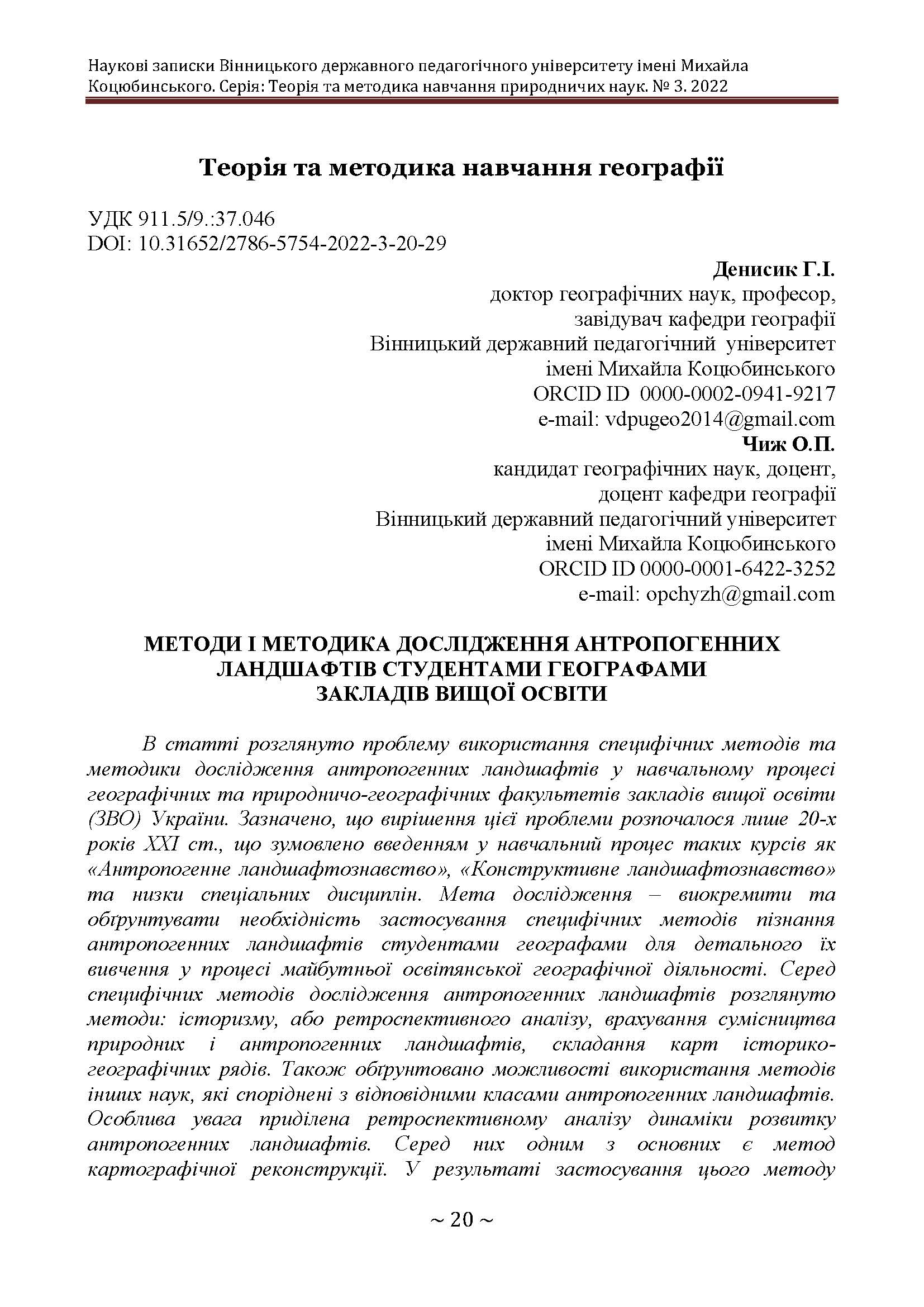Abstract
The article examines the problem of using specific methods and techniques for the study of anthropogenic landscapes in the educational process of geographical and natural-geographical faculties of higher education institutions (HEI) of Ukraine. It is noted that the solution to this problem began only in the 20s of the 21st century, which is due to the introduction of such courses as «Anthropogenic landscape science», «Constructive landscape science» and a number of special disciplines into the educational process. The purpose of the study is to identify and substantiate the need for the application of specific methods of learning anthropogenic landscapes by student geographers for their detailed study in the process of future educational geographical activity. Among the specific methods of studying anthropogenic landscapes, the methods of historicism or retrospective analysis, taking into account the coexistence of natural and anthropogenic landscapes, the method of compiling maps of historical and geographical series, as well as the possibility of using methods of other sciences that are related to the corresponding classes of anthropogenic landscapes are considered. Special attention is paid to the retrospective analysis of the dynamics of the history of the development of anthropogenic landscapes. Among them, one of the main ones is the cartographic reconstruction method. As a result of the application of this method, geographer students have the opportunity to create a historical-genetic series of maps on which the most characteristic time sections of the development of anthropogenic landscapes of the studied region are displayed. It is also noted that the method of natural- anthropogenic coexistence is closely related to the cartographic reconstruction method, which enables geographer students to substantiate the reconstruction of modern anthropogenic landscapes in the future with the aim of their rational use.
Approaches to the use of these methods in the educational process are considered on the example of the study of man-made landscapes, which most vividly represent anthropogenic landscapes. On the example of the mining and industrial landscapes of the outskirts of the town of Turbiv, Vinnytsia region, the methodology of their research is shown jointly by teachers and students of the Faculty of Natural Sciences and Geography of the Vinnytsia Mykhailo Kotsiubynskyi State Pedagogical University and students of senior classes of the Turbiv secondary school. In the future, it is necessary to specify the methods of related studies according to each class of anthropogenic landscapes.
References
Воропай Л. И. Куница М.Н. Селитебные геосистемы физико-географических районов Подолии. Черновцы. ЧГУ. 1982. 90 с.
Денисик Г. І. Антропогенні ландшафти Правобережної України: монографія. Вінниця. Арбат. 1998. 292 с.
Денисик Г. І. Антропогенне ландшафтознавство: Навчальний посібник. Вінниця. Вінницька обласна друкарня. Частина 1. 2014. 334 с.
Кілінська К. Й. Еколого-прогнозуюча оцінка природно-господарської різнома- нітності Карпатсько-Подільського регіону України. Чернівці. Рута. 2007. 492 с.
Казаков В.Л., Ярков С.В. Антропогенні ландшафти Криворіжжя: історія розвитку, структура. Географічні дослідження Кривбасу. Кривий Ріг. Видавничий дім. 2007. С. 27-36.
Назарук М.М., Жук Ю.І., Бота О.В. Малі міста Львівської області: конструктивно-географічні дослідження. Львів. ПП Сорока Т.Б. 2020. 202 с.
Петлін В.М., Міщенко О.В. Прикладне ландшафтознавство: підручник. Луцьк. Вежа – Друк. 2021. 328 с.
Серія із 9 монографій «Антропогенні ландшафти Поділля». Вінниця. 2005- 2020.
Шищенко П.Г. Принципы и методы ландшафтного анализа в региона-льном проектировании: монография. Киев. Фитосоциоцэнтр. 1999. 284 с.

This work is licensed under a Creative Commons Attribution 4.0 International License.
Copyright (c) 2022 Григорій Денисик, Ольга Чиж

